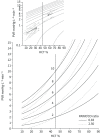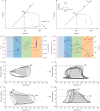The physiological basis of pulmonary arterial hypertension
- PMID: 34737219
- PMCID: PMC9203839
- DOI: 10.1183/13993003.02334-2021
The physiological basis of pulmonary arterial hypertension
Abstract
Pulmonary arterial hypertension (PAH) is a rare dyspnoea-fatigue syndrome caused by a progressive increase in pulmonary vascular resistance and eventual right ventricular (RV) failure. In spite of extensive pulmonary vascular remodelling, lung function in PAH is generally well preserved, with hyperventilation and increased physiological dead space, but minimal changes in lung mechanics and only mild to moderate hypoxaemia and hypocapnia. Hypoxaemia is mainly caused by a low mixed venous oxygen tension from a decreased cardiac output. Hypocapnia is mainly caused by an increased chemosensitivity. Exercise limitation in PAH is cardiovascular rather than ventilatory or muscular. The extent of pulmonary vascular disease in PAH is defined by multipoint pulmonary vascular pressure-flow relationships with a correction for haematocrit. Pulsatile pulmonary vascular pressure-flow relationships in PAH allow for the assessment of RV hydraulic load. This analysis is possible either in the frequency domain or in the time domain. The RV in PAH adapts to increased afterload by an increased contractility to preserve its coupling to the pulmonary circulation. When this homeometric mechanism is exhausted, the RV dilates to preserve flow output by an additional heterometric mechanism. Right heart failure is then diagnosed by imaging of increased right heart dimensions and clinical systemic congestion signs and symptoms. The coupling of the RV to the pulmonary circulation is assessed by the ratio of end-systolic to arterial elastances, but these measurements are difficult. Simplified estimates of RV-pulmonary artery coupling can be obtained by magnetic resonance or echocardiographic imaging of ejection fraction.
Copyright ©The authors 2022.
Conflict of interest statement
Conflicts of interest: R. Naeije reports relationships including consultancies, speaker fees and membership of advisory boards with AOP Orphan Pharmaceuticals, Johnson & Johnson, Lung Biotechnology Corporation and United Therapeutics. Conflicts of interest: M.J. Richter has received funding from the German Research Foundation (DFG, 413584448) and from the Collaborative Research Center (SFB) 1213 – Pulmonary Hypertension and Cor Pulmonale (grant number SFB1213/1, project B08; German Research Foundation, Bonn, Germany). Conflicts of interest: L.J. Rubin reports consultancies with Actelion, SoniVie, Gossamer Bio and Bellerophon.
Figures








References
-
- Wagenvoort CA, Wagenvoort N. Primary pulmonary hypertension: a pathologic study of the lung vessels in 156 clinically diagnosed cases. Circulation 1970; 42: 1163–1184. doi:10.1161/01.CIR.42.6.1163 - DOI
Publication types
MeSH terms
LinkOut - more resources
Full Text Sources
Medical
